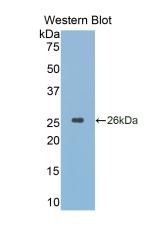Monoclonal Antibody to Cathepsin K (CTSK) 

CTS-K; CTS02; CTSO; CTSO1; CTSO2; PKND; PYCD; Pycnodysostosis; Cathepsin O; Cathepsin X
- UOM
- FOB US$ 128.00 US$ 298.00 US$ 426.00 US$ 1,065.00 US$ 4,260.00
- Quantity
Overview
Properties
- Product No.MAA267Si21
- Organism SpeciesRhesus monkey (Simian) Same name, Different species.
- ApplicationsWB; IHC; ICC; IP.
If the antibody is used in flow cytometry, please check FCM antibodies.
Research use only - DownloadInstruction Manual
- CategoryEnzyme & KinaseInfection immunityBone metabolism
- SourceMonoclonal antibody preparation, Host Mouse
- Ig Isotype IgG1 Kappa, Clone Number 1#
- PurificationProtein A + Protein G affinity chromatography
- LabelNone
- Immunogen RPA267Si01-Recombinant Cathepsin K (CTSK)
- Buffer FormulationPBS, pH7.4, containing 0.02% NaN3, 50% glycerol.
- TraitsLiquid, Concentration 1mg/mL
Sign into your account
Share a new citation as an author
Upload your experimental result
Review

Contact us
Please fill in the blank.
Specifity
The antibody is a mouse monoclonal antibody raised against CTSK. It has been selected for its ability to recognize CTSK in immunohistochemical staining and western blotting.
Usage
Western blotting: 0.01-2µg/mL;
Immunohistochemistry: 5-20µg/mL;
Immunocytochemistry: 5-20µg/mL;
Optimal working dilutions must be determined by end user.
Storage
Store at 4°C for frequent use. Stored at -20°C in a manual defrost freezer for two year without detectable loss of activity. Avoid repeated freeze-thaw cycles.
Stability
The thermal stability is described by the loss rate. The loss rate was determined by accelerated thermal degradation test, that is, incubate the protein at 37°C for 48h, and no obvious degradation and precipitation were observed. The loss rate is less than 5% within the expiration date under appropriate storage condition.
Organism Species More: Homo sapiens (Human), Mus musculus (Mouse), Rattus norvegicus (Rat)Giveaways
Increment services
-
 Antibody Labeling Customized Service
Antibody Labeling Customized Service
-
 Protein A/G Purification Column
Protein A/G Purification Column
-
 Staining Solution for Cells and Tissue
Staining Solution for Cells and Tissue
-
 Positive Control for Antibody
Positive Control for Antibody
-
 Tissue/Sections Customized Service
Tissue/Sections Customized Service
-
 Phosphorylated Antibody Customized Service
Phosphorylated Antibody Customized Service
-
 Western Blot (WB) Experiment Service
Western Blot (WB) Experiment Service
-
 Immunohistochemistry (IHC) Experiment Service
Immunohistochemistry (IHC) Experiment Service
-
 Immunocytochemistry (ICC) Experiment Service
Immunocytochemistry (ICC) Experiment Service
-
 Flow Cytometry (FCM) Experiment Service
Flow Cytometry (FCM) Experiment Service
-
 Immunoprecipitation (IP) Experiment Service
Immunoprecipitation (IP) Experiment Service
-
 Immunofluorescence (IF) Experiment Service
Immunofluorescence (IF) Experiment Service
-
 Buffer
Buffer
-
 DAB Chromogen Kit
DAB Chromogen Kit
-
 SABC Kit
SABC Kit
-
 Long-arm Biotin Labeling Kit
Long-arm Biotin Labeling Kit
-
 Real Time PCR Experimental Service
Real Time PCR Experimental Service
Citations
- MRMT-1 rat breast carcinoma cells and models of bone metastases: improvement of an in vitro system to mimic the in vivo condition.PubMed: S0065128112000773
- Biochemical and clinical correlation of intraplaque neovascularization using contrast-enhanced ultrasound of the carotid arteryPubmed:24534452
- Drynaria total flavonoids decrease cathepsin K expression in ovariectomized ratsPubmed:25036175
- In vitro method for the screening and monitoring of estrogen-deficiency osteoporosis by targeting peripheral circulating monocytesPubMed: 26250906
- Cathepsin K Contributes to Cavitation and Collagen Turnover in Pulmonary TuberculosisPubMed: 26416658
- Effect of Vitamin D on Peripheral Blood Mononuclear Cells from Patients with Psoriasis Vulgaris and Psoriatic Arthritispmc:PMC4822855
- TSC1 regulates osteoclast podosome organization and bone resorption through mTORC1 and Rac1/Cdc42Pubmed:29358671
- Comparative evaluation of cathepsin K levels in gingival crevicular fluid among smoking and nonsmoking patients with chronic periodontitisPubmed: 30409937
- A bioactive exopolysaccharide from marine bacteria Alteromonas sp. PRIM-28 and its role in cell proliferation and wound healing in vitroPubmed: 30851325
- Biomarkers of Compromised Implant Fixation
- Compound K induces neurogenesis of neural stem cells in thrombin induced nerve injury through LXRα signaling in micePubmed: 32371156
- Информационный алгоритм неинвазивной оценки остеорезорбтивного побочного действия глюкокортикостероидов у больных язвенным колитом
- Особенности остеоиммунологических аспектов остеорезорбции при периимплантите, хроническом пародонтите и раке альвеолярного отростка и …






